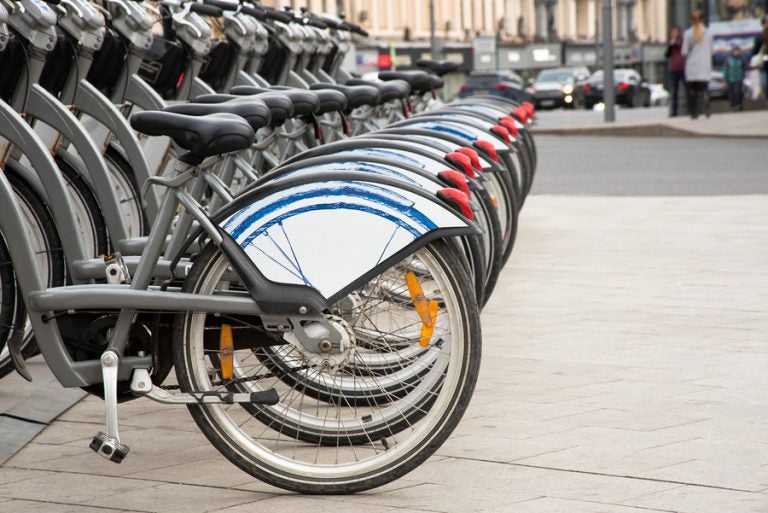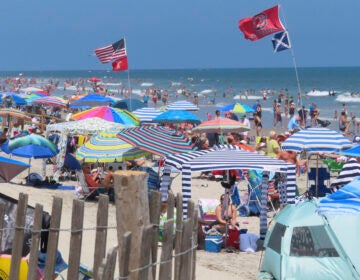Do bike-share programs make sense for the Jersey Shore?

Bike-share programs allow anyone with a credit-card to rent a bike on the spot. (Big Stock photo)
Biking and the Jersey Shore go together like peanut butter and jelly, salt and pepper, boardwalk fries and indigestion. But until recently, there have only been two main options for getting a cycling fix while on vacation — you either lug a bike from home, or you rent one after you get here.
That changed on Aug. 25 when Asbury Park took a leap of faith and launched a multi-unit bike-sharing program. Riders can access bikes via a smartphone app at unmanned docking stations. It’s the first model of its kind at the Jersey Shore. And in the two months following launch, the program — which includes 30 bikes distributed between six stations — saw more than 1,000 trips, and attracted more than 600 members.
“The message is that bicycling is for everyone, and we’re trying the best we can to make that happen,” said Michael Manzella, Asbury Park’s transportation manager. “We want to be a biking and pedestrian mecca.”
Other shore towns may be following suit. Some can’t wait for this two-wheeled renaissance. Others think the idea needs a tuneup before it makes its way to the beach, where too much bicycling congestion can already be a headache, and where some city officials anticipate pushback from existing bike rental businesses. Either way, the offseason conversation happening now could have major implications for your pedaling routine come summer.
The bike-share boom
These programs — which accounted for 28 million U.S. bike trips in 2016, or approximately the ridership of the entire Amtrak system — have traditionally been a big-city staple for commuters looking to combat road congestion. And they’re not likely to disappear. By 2020, bike sharing’s global market share is expected to reach $6.3 billion.
More recently — enticed by a slew of new, more affordable program options — smaller communities have been increasingly drinking the bike-share Kool-Aid. For instance, Boston launched its first program in 2011, and now 16 smaller towns and cities in the surrounding area are planning a regional network.
But could bike-share success translate to small Jersey beach towns?
Asbury Park is banking on it. The program here was done in partnership with bike-sharing firm Zagster, which caters specifically to smaller markets. It cost $54,000 to implement, but because of sponsorships obtained for each docking station, the city didn’t put out a cent of that. And it plans on putting all revenue from user fees (riders pay $3 per hour or sign up for an annual $30 membership) into an expansion of the bike-share. Once the program has existed long enough to trend its data, the goal over the next year or so is to sign adjacent towns onto the program, so a rider could theoretically pick up a bike in Asbury Park and leave it in, say, Belmar, or vice versa.
Bike-sharing planned for Absecon Island
Farther south, Vincent Sacco of Shore Bike Share LLC is planning his own bike-share empire. Last year, he presented the concept for a program that would service the Absecon Island communities — Ventnor, Margate, Longport and Atlantic City — as well as Somers Point. Though a single bike-sharing rack already operates out of the Claridge Hotel in Atlantic City, Sacco envisions the need for a more expansive program, because a Stockton University residential campus is planned here for 2018, and college campuses tend to be “ideal for the systems,” according to Forbes.
So far, Sacco said, he’s gotten a definitive greenlight from Ventnor and Somers Point, though he’s still working through logistics with each town so there is no timeline for execution. To avoid saturating the market, he doesn’t envision the entire program encompassing more than 300 bikes on the island. His hope is that they’ll be accessible 24 hours a day.
“In the future, bike-sharing will be commonplace at the Jersey Shore,” he said. “We’ll be as familiar with it as we are with catching the jitney.”
In August, Asbury Park began charging for 64 previously free parking spaces a few blocks from the beach. The move led to grumbling among visitors about money-grubbing, especially considering the $4.9 million the town had earned the year before in parking revenue. But the decision, city officials said, was an attempt to increase parking turnover, since the limited availability is frustrating for visitors.
The bike-share program has proven a less controversial solution to parking woes. And though it’s too early to quantify exactly how much car congestion relief it will bring, enthusiasm for the program suggests it’s already working to get cars off the road — a common goal for most shore towns. (To give an idea of just how bad parking can be at the shore, NJ.com once published an article advising people to bring smaller cars to the beach, even if it means leaving your “giant cooler and beach umbrella and your kids at home.”)
Possible benefits from bike-sharing
There’s reason to believe Jersey Shore-goers might be especially willing to ditch their vehicles for a more sustainable mode of transportation. First, there are the myriad health benefits — many programs have built-in health-tracking devices, so users get calorie burn updates and other data for each trip. Secondly, people along the coast are more likely to believe in man-made climate change, research shows, since they’ve got a front-row seat to sea-level rise. And since tailpipe emissions constitute 27 percent of greenhouse gas emissions in the U.S., cars are increasingly becoming transport non grata. Bike-share proprietors may be able to capitalize on this environmental awareness. The plan at Shore Bike Share LLC, for example, is to incorporate solar-powered electric bikes and locks so “the footprint is zero,” Sacco said.
But the biggest motivator for shore towns looking to get into the bike-share game may be the potential economic boost. Numerous studies reveal cyclists may purchase fewer items per shopping trip, but they make more trips, ultimately spending the same or more as their car-driving peers. In other words, business owners needn’t fear losing nearby parking spaces to increased cycling infrastructure.
Generational divide
Not everyone is so convinced this will be a slam dunk at the Jersey Shore.
The bike-sharing explosion is due, in part, to the expansion of the sharing economy, otherwise known as collaborative consumption, whereby people pay for goods or services — houses, cars, even clothing — they won’t own. Think Airbnb for vacation rentals, or Uber for ride sharing. But this is largely a Millennial-driven phenomenon. In New York City, analyzing the stats of the most-used bicycle in its Citi bike program reveals the most common age of its riders to be 28. (The average age of this bicycle’s riders is 38.)
“Young people are much better at this than older folks,” said Bill Quain, PhD, associate professor of hospitality and tourism management at Stockton University. “Older folks want to own something. That’s how we were raised — buy something, take care of it. Part of the fun of having a bike is having a piece of equipment you really like in a color you like, working on it and adding to it. For the younger generation, this isn’t so important. They don’t even own TVs.”
For this reason, Quain said, he doesn’t envision bike-sharing taking off just yet in shore communities, where demographics can skew older — though a bike-share/rental combo could be a workable model. The age obstacle could be further compounded by the fact that most bike-share riders have traditionally been commuters looking to get to and from work — not exactly a primo market at the Jersey Shore during peak season.
In Ocean City, New Jersey, where the median age is 54.5, public information officer Doug Bergen says no one has approached the city yet about launching a bike-sharing program, and no feasibility studies have been conducted.
“Though, conceptually, we’d be interested,” he said, adding that the city is currently working on expanding its cycling infrastructure, so that it can safely accommodate thousands of bicycles at any given time before summer 2018. “Once this is in place, it could lead to something like a bike-sharing program. We’re pro-bike, and looking for ways to encourage that in any way we can.”
Do we need more bikes?
Other towns are more wary of the idea. In both Seaside Heights and Cape May, officials said they’re turned off by the possibility of taking business away from established bike rental outlets, already fully capable of meeting each city’s biking needs. (Interestingly, a report from the Federal Highway Administration indicates that bike-share programs can actually benefit rental shops by sending them riders looking for helmets and other accessories.)
In Stone Harbor, according to recreation director Miranda Duca, bike sharing was a “blip on the radar” a couple of years ago. It was ultimately decided that bicycle congestion is already too great a problem, even with designated bike lanes that run the length of the island. The focus now is on alleviating that with greater infrastructure, including the implementation of bicycle rest stop stations.
Farther south, the deterrent is safety. “Every north-south street I have is a major highway, and I don’t want to put people in harm’s way,” said Wildwood Mayor Ernie Troiano. “We’re a whole different animal than some of those other shore communities. But it’s something we’d be willing to talk to somebody about. It can’t hurt to have a conversation.”
The theft question
Interestingly, none of the wary city officials contacted for this story mentioned some of the more reported potholes befalling bike-share programs — theft and vandalism. In September, Baltimore had to shut down it’s $2.6 million bike-share program because so many bikes were stolen or destroyed. In Paris, 80 percent of bike-share bikes met the same fate.
This seems as though it would be of particular concern at the Jersey Shore — after all, between 2009 and 2013, Cape May County saw an average of more than 848 bikes stolen per year. In Atlantic County, that average is 445. In Ocean County, it’s 706. And in Monmouth County, where Asbury Park is located, that number is 759.
In fact, Asbury Park has had such a struggle policing bike theft, they’ve recently launched a bike registration program. Yet, the town has had no issues with either theft or vandalism within its bike share since the launch.
“A lot of our issues have stemmed from the fact that people just don’t realize they need to lock their bikes up,” Manzella said. “But people are especially motivated to do so with a bike-share bike, because they’ve paid for the ride with a credit card just prior to use. So if it goes missing, we know who to charge.”
Additionally, the built-in locks required for a bike-share bicycle in Asbury Park are so thick, they require a special tool for cutting. As an additional measure, all rear tires lock as well. In many programs, bicycles are equipped with graffiti-resistant paint, GPS tracking, or custom parts that can’t be transferred to a non-bike-share bike. Suddenly, what may have felt to would-be thieves like a low-key or even juvenile crime to commit for kicks while letting loose on vacation at the Jersey Shore — say, nabbing an unlocked bike as a way to get home from a bar after a night of drinking — now feels more like a bona-fide and far too risky felony.
Asbury Park is not unusual — the aforementioned report from the Federal Highway Administration indicates theft and vandalism are “not major issues” at U.S. bike shares; the theft rate is less than 0.5 percent.
The final say
So when it comes to the feasibility of bike-sharing at the Jersey Shore, who is right: the enthusiasts or the naysayers? Turns out, both.
In 2013, the Institute for Transportation and Development Policy analyzed bike shares around the world to see what makes for a successful program. Their findings, which were published as the Bike-Share Planning Guide, detail some criteria that would discount some Jersey Shore towns by themselves.
For instance, according to the guide, the minimum coverage area should be about four square miles, or “large enough to contain a significant number of user origins and destinations.” Meanwhile, the entire town of Wildwood is not quite 1.5 square miles.
But for the most part, these guidelines have less to do with location, and more to do with the management of a specific program. Specifically, the bikes should be high-quality, durable and well-maintained, there should be enough bikes and stations to make sense (10-30 bikes for every 1,000 residents, and 10-16 stations for every square kilometer), and stations should be easy to use.
In other words, standards that could be met anywhere (okay, anywhere with a fairly dense population). So maybe we shouldn’t be discussing whether or not bike-shares can work at the Jersey Shore but, rather, what we’re doing to make them work.
“You can accomplish a bike-share anywhere, as long as you have a city or organization that’s willing to see the entire picture,” said Jemilah Magnussun, global communications director at the institute. “This means making sure cycling is safe — the bikes won’t be crossing any major highways or areas built only for cars — and the infrastructure is in place.”
Or, as skeptical Professor Quain put it: “The Jersey Shore is a magical spot, so maybe it’s a great place for anything.”
WHYY is your source for fact-based, in-depth journalism and information. As a nonprofit organization, we rely on financial support from readers like you. Please give today.





